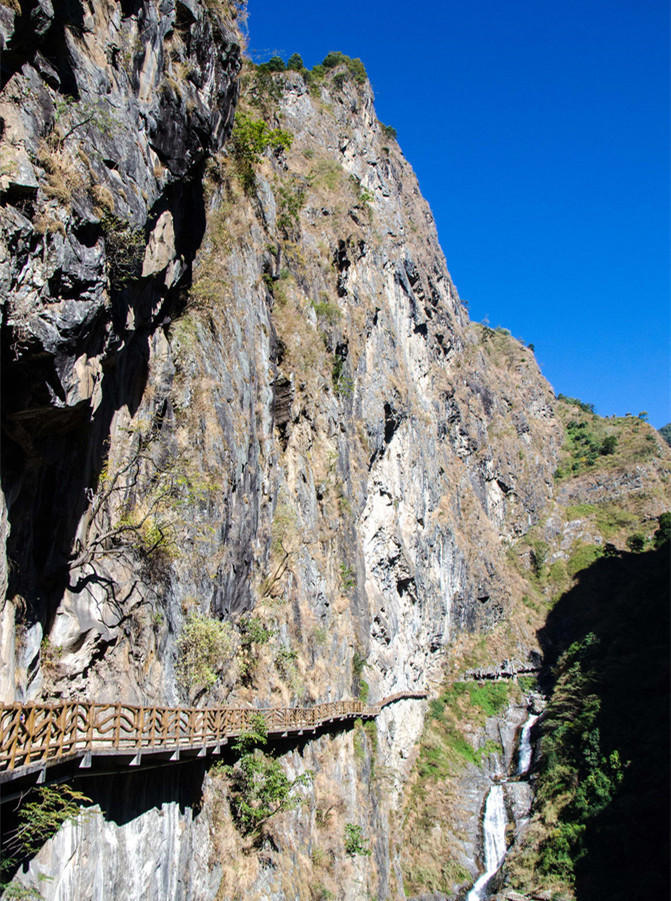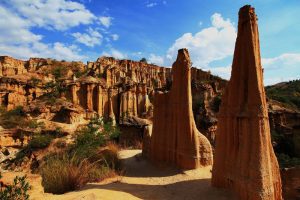Behind Cangshan (苍山) in Dali (大理), beside the Jinsha River (江边), there are two towering cliff gorges that rise several hundred meters high, resembling massive stone gates. Crystal-clear waterfalls cascade down from these cliffs, creating a magnificent natural spectacle. The surrounding terrain is rugged with steep rock faces, deep valleys, and fast-flowing streams. Shimen Pass (石门关) is like a place sculpted by gods and spirits, embodying the aura of “one man guards the pass, ten thousand cannot break through.”
Also known as Dali Cangshan Shimen Pass (大理苍山石门关), this site is an important part of the Cangshan National Geopark (苍山国家地质公园), National Nature Reserve (国家级自然保护区), and National Scenic Area (国家级风景名胜区) within the Cang’er Scenic Zone (苍洱景区). It is about 399 kilometers from Kunming (昆明市), 24 kilometers from Dali City (大理市), and just 8 kilometers from the county seat of Yangbi (漾濞县城). The planned area of the scenic zone covers 28.2 square kilometers.
In 1993, the site was approved by the Yunnan provincial government as a provincial-level scenic area, and in 2001, it was rated as a national AA-level tourist attraction. Notable attractions include Misty Shimen (雾锁石门), Evening Bell of Fuguo (福国晚钟), Clear Void Valley (澄明虚谷), Fragrant Orchids in the Cliffs (崖涧幽兰), Reluctant Farewell by Xu Xiake (霞客忘归), Jade Splashing Pool (碧潭溅玉), Books of Heaven (万卷天书), Skywalk on the Clouds (凌云栈道), Jade Emperor’s Green Emergence (玉皇涌翠), and Sunset over Cangshan (苍山夕照).
The Dali Yangbi Cangshan Shimen Pass Tourism Development Co., Ltd. is carrying out phased ecological restoration and planning, with a projected investment of 1 billion RMB. According to the standards of a national 5A-level scenic area, plans include one visitor center, two scenic roads, seven themed tourism areas for sightseeing, leisure, and vacation, and three major supporting service facilities—featuring China’s only high-altitude skywalk in the west and the world’s largest vertical-drop tourist cableway.
With the slogan “Heaven Opens Shimen, Enter Cangshan” (天开石门,走进苍山), this untouched “virgin land” of tourism is ready to welcome domestic and international visitors seeking wellness, vacation, and relaxation.

- Chinese Name: 漾濞石门关
- Location: Dali Bai Autonomous Prefecture (大理白族自治州), Yunnan Province (云南省)
- Opening Hours: Monday to Friday, 08:00–18:30, year-round
- Rating: National-level
- Area: 28.2 km²
- Alternate Name: Dali Cangshan Shimen Pass (大理苍山石门关)
Scenic Features
Shimen Pass (石门关) is a classic canyon landscape, originating from the Jinzan River (金盏河), which flows from Yujufeng Peak (玉局峰) of Cangshan (苍山). The canyon is V-shaped, with the northern cliff reaching 2,321.8 meters at Jin’an Temple (金庵寺), and the southern cliff rising to 1,760 meters. The main waterfall lies at an elevation of around 2,000 meters.

The canyon stretches about 1,200 meters, with the stone gate section itself about 600 meters long, 100 meters wide at the top, and rock walls ranging from 200 to 500 meters in height. The rock formations consist of gneiss and marble. The southern side is called Cuiping Mountain (翠屏山), and the northern side is Qingliang Mountain (清凉山). Vegetation includes secondary Pinus yunnanensis (云南松), Keteleeria evelyniana (滇油杉), Vaccinium (南烛), Symplocos (小铁仔), and crowberry thickets (老鸦泡灌丛林). Subtropical broadleaf forests in the canyon feature wild banana (野芭蕉), Pterocarya stenoptera (枫杨), Brugmansia (旱冬瓜), Cinnamomum (樟), and Quercus aliena (麻栎).
Shimen Pass is one of the sixteen ancient scenic spots of Yangbi (漾濞古十六景), historically referred to as “Heaven Opens Shimen” (天开石门).
The towering cliffs and deep gorge create a scene as if carved by divine hands, echoing the sentiment: “One man guards the pass, ten thousand cannot breach it.” The most astonishing discovery nearby is a 16-square-meter cliff painting, found in October 1994 on the mountain behind Songlin Village (松林村). The mural includes over 200 images of animals, humans, fruit trees, handprints, houses, hunting scenes, and circle dances—ranging in size from 5 cm² to 1 m².
Historical Records
The famous Ming dynasty traveler Xu Xiake (徐霞客) described Shimen Pass in his travel notes:
“Looking east, I suddenly saw the clouds part and two green lotus petals pierced the earth, standing tall and facing each other. Within them were high peaks overlapping in the mist, making my spirit soar.”
He also wrote: “Looking toward Shimen, it was so close, the cliffs stood tightly opposite each other, each soaring thousands of feet, no more than 20 feet apart. Their tops and bases aligned perfectly, just enough to let a stream pass… The cliffs are like blades cutting through clouds—truly a spectacular sight.”
Local Cuisine
The Bai (白族) people favor sour, spicy, sweet, and mildly numbing flavors. Their cooking is influenced by Han (汉族) and Buddhist temple cuisines. Signature dishes include:
- Stir-fried pot fish (炒锅鱼)
- Sand-washed cheese sheets (洗沙乳扇)
- Dali rice cakes (大理饵块)
- Xi Zhou flaky sugar pastry (喜洲破酥糖招)
- Boiled live fish in mountain spring water (活水煮活鱼)
- Steamed pork with willow strips (柳条蒸肉)
Kaocha (烤茶) is a traditional Bai tea custom for hosting guests. The tea is thick and aromatic, usually served in three rounds, known as “Three-Course Tea” (三道茶)—the first bitter, the second sweet, the third with a lingering aftertaste.
Traditional snacks like wanmei (婉梅) and diaomei (雕梅) are popular among Bai women.
To sample authentic Dali cuisine, head to Huguo Road (护国路) in the Dali Ancient Town (大理古城), where you’ll find many restaurants and Western-style cafes that reflect the ethnic diversity of the Bai and Tibetan people. Taibai Pavilion (太白楼), famous for its Three-Course Tea and Tibetan Butter Tea (酥油茶), is especially popular among foreign visitors.
What makes the Ancient Town even more appealing than its food is the peaceful atmosphere. In the cafés and restaurants, guests can listen to music, enjoy a cold beer, and spend a relaxing afternoon.
Tip: Most cafés in the area provide tourist information and ticket booking services. Some also offer bicycle rentals for exploring the surroundings.

 7 Days GolfingTour
7 Days GolfingTour
 8 Days Group Tour
8 Days Group Tour
 8 Days Yunnan Tour
8 Days Yunnan Tour
 7 Days Shangri La Hiking
7 Days Shangri La Hiking
 11 Days Yunnan Tour
11 Days Yunnan Tour
 6 Days Yuanyang Terraces
6 Days Yuanyang Terraces
 11 Days Yunnan Tour
11 Days Yunnan Tour
 8 Days South Yunnan
8 Days South Yunnan
 7 Days Tea Tour
7 Days Tea Tour
 8 Days Muslim Tour
8 Days Muslim Tour
 12 Days Self-Driving
12 Days Self-Driving
 4 Days Haba Climbing
4 Days Haba Climbing
 Tiger Leaping Gorge
Tiger Leaping Gorge
 Stone Forest
Stone Forest
 Yunnan-Tibet
Yunnan-Tibet
 Hani Rice Terraces
Hani Rice Terraces
 Kunming
Kunming
 Lijiang
Lijiang
 Shangri-la
Shangri-la
 Dali
Dali
 XishuangBanna
XishuangBanna
 Honghe
Honghe
 Kunming
Kunming
 Lijiang
Lijiang
 Shangri-la
Shangri-la
 Yuanyang Rice Terraces
Yuanyang Rice Terraces
 Nujiang
Nujiang
 XishuangBanna
XishuangBanna
 Spring City Golf
Spring City Golf
 Snow Mountain Golf
Snow Mountain Golf
 Stone Mountain Golf
Stone Mountain Golf

















